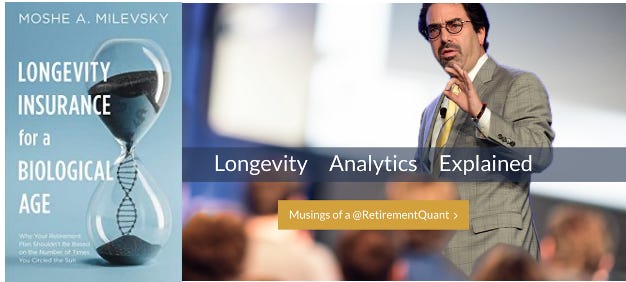#10 reversible destiny
Hidden in Plain Sight: Reversible aging, longevity analytics, super evolution, epigenetic tests
reversible destiny
We live in a mega-evolutionary era in which a significant event—in this case, the increasing pace of technology development—causes radical, multi-generational change. The result: A super evolution. We are witnessing a revolution in aging, longevity, wellness and health. A proliferation of data, ubiquitous computing and advanced engineering are making it possible to learn from and improve the physical and biological worlds at a significantly faster pace than ever before. reversible destiny is here.
the new lifespan: why aging might be reversible
Harvard researcher and biotech founder Dr. David Sinclair theorizes in his New York Times best-selling book “Lifespan” that aging doesn’t have to be inevitable.
"Every year you stay alive, you get another three months of life. Because technology is advancing, and it's been going up across the world in advanced nations continuously over the last 200 years. And there's no sign that it's slowing down. If anything, it's going to speed up. There is a chance that the first person to live to 150, is already with us on the planet."
Dr. Sinclair is co-founder of several biotechnology companies (Sirtris, Ovascience, Genocea, Cohbar, MetroBiotech, ArcBio, Liberty Biosecurity) and head of the Sinclair Lab at Harvard Medical School. His research has been primarily focused on the sirtuins, protein-modifying enzymes that respond to changing NAD+ levels and to caloric restriction (CR) and his lab was the first to identify a role for NAD+ biosynthesis in regulation of lifespan. One of the molecules researched is nicotinamide mononucleotide (NMN). NMN is converted into NAD+, which is a cofactor of sirtuins and other DNA-repairing molecules. Their research is behind the development of new anti-aging supplements with NAD+ like Basis by Elysium Health.
WATCH: OnPoint WBUR interview with Dr. Sinclair
longevity analytics: do you have a long life strategy?
Chronological age is a poor metric that we should not be using. According to Professor Moshe Milevsky at York University in Toronto, today’s foremost authority on retirement finance and author of Longevity Insurance for a Biological Age: Why Your Retirement Plan Shouldn’t Be Based on the Number of Times You Circled the Sun, thinking in chronological years distorts your work strategy, asset allocation, life insurance, retirement planning, and everything else. Milevsky advocates a new individual financial strategy, such as a greater proportion of equities or an annuity. His book examines the personal financial implications of extreme longevity and how to guarantee a sustainable income stream for the remainder of your biological life. Or, as he puts it: “Buy some insurance today, because tomorrow you might find out you’re younger.”
A new demographic dividend – the “longevity dividend” —is emerging as populations age around the world. Longevity will have a dramatic impact on public retirement policy, raising the bar on the age you can claim, and start collecting on, government pensions or IRAs. Shifting our age measures to biological ones will help make longevity risk as salient as mortality risk, which will one day make annuities as “legitimate” as life insurance now is.
If we can target the biology of aging, we can delay age-related disease, save health care costs and add life to our years. These new health, economic and societal gains are what the American Federation for Aging Research (AFAR) calls the “longevity dividend” we need to plan for.
the super evolution is here, speeding up the product development cycle
Recognizing that technology could help alleviate global problems by increasing the pace of innovation, Eric Schmidt (formerly Google) Dror Berman, co-founders of Innovation Endeavors coined their thesis the "Super Evolution."
The optimistic drive for this accelerated rate of change involves rapid technological advancements in three converging areas — data, leading-edge computation and advanced engineering —to speed up the product development cycle.
Despite all the technological advances in the past two decades, "we were only scratching the surface in using technology to solve critical challenges around topics such as healthcare or climate.," states Berman.
The good news is that we now have the tools to make significant, fast world-changing solutions:
• A proliferation of data from the physical and biological worlds is giving us endless information about things we could never measure before.
• Machine learning and edge computing make computational power cheaper and stronger than ever, so that it has become easier and faster to ingest data and drive insights. This allows us to discover and understand complex patterns and make predictions.
• Advances in engineering, such as robotics, 3D printing and CRISPR make it possible for us to translate those insights into action in the biological and physical worlds quickly and cost effectively.
SOURCE: Innovation Endeavors
home epigenetic-aging test measures biological and cumulative rate of aging.
From the labs to your home: we can now measure our aging clocks down to the epigenetic level. Similar to the DNA tests that help you discover your family tree and genetic dispositions, there are a new wave of clock-testers in our race to slow down our aging.
Index, a revolutionary at-home test developed by Elysium Health, tracks how fast you’ve been aging using the latest generation technology in the science of epigenetics.
A study published in Nature Aging validates the superior reliability and precision of the algorithmic approach powering Index, Elysium’s biological age predictor. The researchers observed that, when the same DNA sample is measured multiple times, systemic variation inherent in the methodology can obfuscate the results. In some clocks, this variability in biological age was up to nine years. To improve clock reliability, the researchers applied a computational solution known as principal component analysis (PCA) to remove “noise” from the information system. Index leverages PCA for a standard deviation of only 1.1 years. Clock reliability is critical for monitoring an individual’s longitudinal aging process and to be able to detect the impact of lifestyle changes and aging interventions on one’s biological age.
📘 The 100 year life is upon us. Get ready. ALICE 's book "Hacking Immortality," explores the breakthrough science and many accessible pathways today to slow down and eventually reverse aging.
Thanks for tuning in.
For more wanderings, become an Alice in Futureland subscriber—it's free.
Invite your friends to this mad tea party and let's see how many things we can learn before breakfast.
©2023 Alice in Futureland









